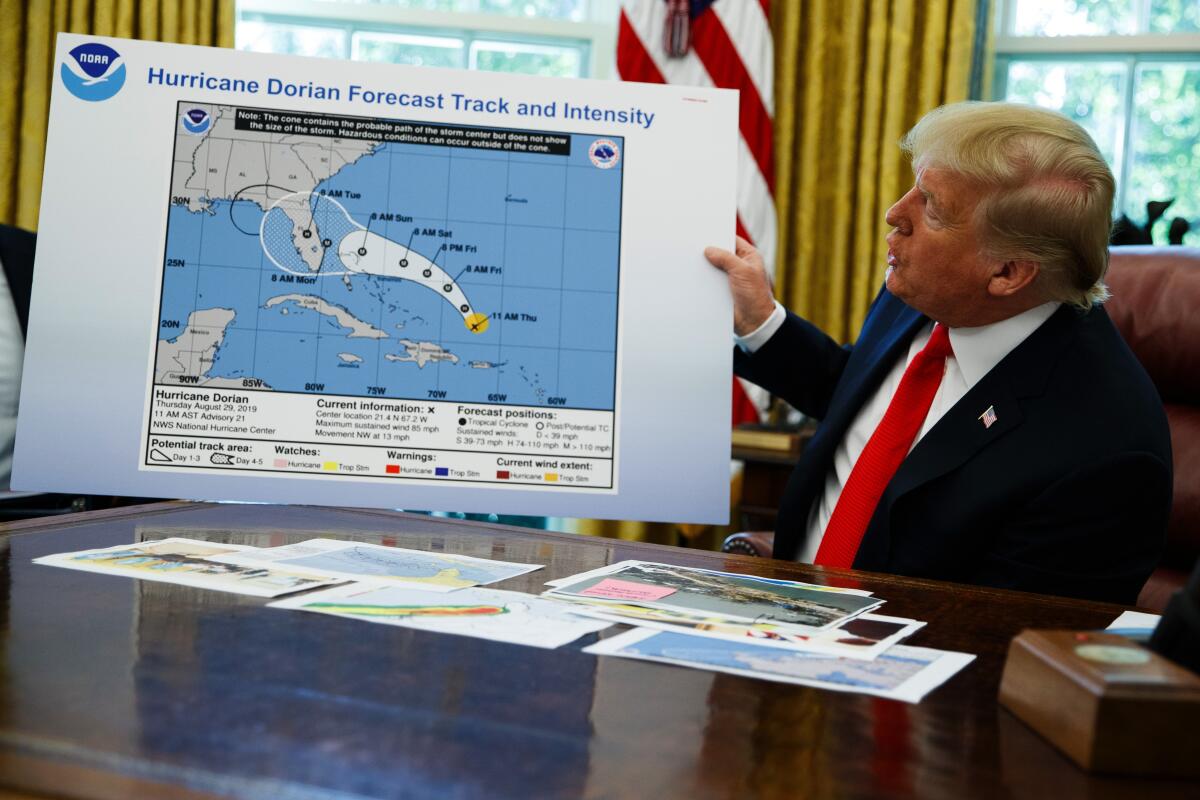‘Sharpiegate’ is nothing to laugh at. It’s one more example of Trump’s unchecked presidential powers

- Share via
When a White House Sharpie user recently doctored a National Hurricane Center map to expand the projected path of Hurricane Dorian to Alabama, media critics and the Twitter-verse exploded. Here’s proof positive, they said, that President Trump ignores reality and literally stretches the truth to serve his own political purposes and to stroke his own fragile ego.
They claimed that his stubborn fixation on the issue — and the later validation of his position by the National Oceanic and Atmospheric Administration — only proved their point. And worst of all, they said, this was a fabrication that mattered enormously to frightened Alabamans who wouldn’t know whether to prepare to be hit or not.
The media rightly covered this story, and rightly criticized Trump. Presidential lies like this demand a response. We all have an obligation to call the president out when he states an untruth — especially those in the media.
But in all the back and forth over “Sharpiegate,” we’ve missed the much more important story. Contrary to what we hear, this isn’t just about presidential lies and delicate egos. It’s about presidential power and the “unitary executive theory,” which posits that the president has unilateral and plenary authority to enforce the law as the president sees fit.
In taking a Sharpie to the center’s map, the president wasn’t just trying to shore up political support or save face; he was actually changing reality, at least as it’s understood for the purpose of policymaking within his administration. This is perhaps the most sweeping, and most breathtaking, kind of executive authority. And it’s real cause for worry.
This isn’t the first time Trump has exercised this kind of presidential authority. Coming into office, he altered the facts, established by national security experts in the executive branch, to justify his Muslim travel ban as a national security measure. As president, he continues to ignore and adapt facts, established by environmental experts in the executive branch, to decimate federal environmental protections. Most recently, he and his administration simply made up a justification (compliance with the Voting Rights Act), flatly contradicted by voting-rights experts in the Justice Department, in a failed quest to add a citizenship question to the census.
In these and many other areas, Trump has a well-established track record of unilaterally fashioning his own false reality within the executive branch, and shaping policies around it.
This power may seem outsized. But it shouldn’t surprise anyone paying attention to shifts in presidential power over the last couple of decades.
In particular, supporters of robust presidential authority have gained substantial traction for their claim that under the Constitution the president is a “unitary executive.”
Under that theory, in order to enforce laws as he sees fit, the president has absolute authority over the entire executive branch, including the bureaucracy and even independent agencies. These include agencies like the Federal Reserve Board and the Consumer Financial Protection Bureau, and offices like the special counsel — all familiar targets of Trump’s political ire.
The unitary executive theory had a breakout appearance in 1988 in a lone dissent by Justice Antonin Scalia, since deceased. In Morrison vs. Olson, Scalia argued that the then-applicable independent counsel law impermissibly intruded on the president’s “unitary” power. Because the president couldn’t summarily fire the independent counsel, Scalia wrote, the president couldn’t fully control that office.
Since then, proponents of the unitary executive, largely political conservatives, waged a legal campaign to transform Scalia’s lone dissent into a mainstream constitutional position (except when it didn’t suit their politics). Today, Scalia’s dissent, and the unitary executive theory it articulates, may well garner a majority on the Supreme Court.
Under the strongest version of the theory, the president, and the president alone, can control every action within the executive branch — including amending findings and conclusions on national security, the environment, voting rights and even altering a National Hurricane Center map.
In other words, when the president reworks or even outright falsifies the work of an agency, he isn’t so much changing the work of the executive branch. He’s actually doing that work — by himself, without oversight, as the unitary executive. That’s a kind of unilateral and unchecked power that no responsible democracy can countenance.
Trump may not understand the unitary executive theory. But we know from so many of his actions — including his efforts to thwart congressional oversight, his use of his office for personal gain, and his moves to politicize the executive branch — that he behaves like he understands the theory. Trump’s excessive unilateral approach to the presidency is the logical extension of the theory, and he’s the natural result of decades of work to promote it. He’s also the best reason to abandon it.
Sharpiegate is yet another example of presidential lies and dissembling. And for that reason, it certainly matters. But it matters, too, for a far more important reason, one that’s been drowned out in all the Sturm und Drang over the doctored weather map — unrestrained presidential power.
Steven D. Schwinn is a professor of constitutional law at the University of Illinois at Chicago John Marshall Law School.
More to Read
A cure for the common opinion
Get thought-provoking perspectives with our weekly newsletter.
You may occasionally receive promotional content from the Los Angeles Times.






